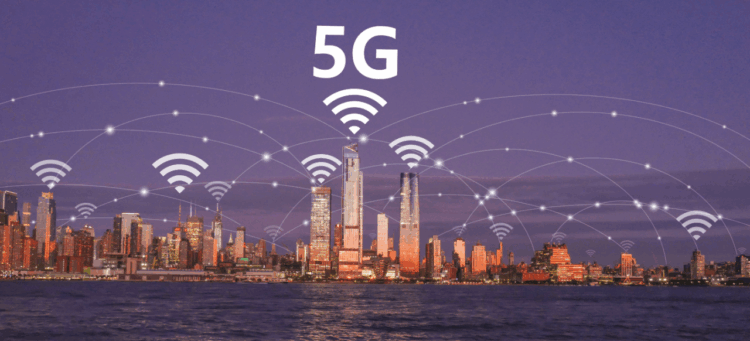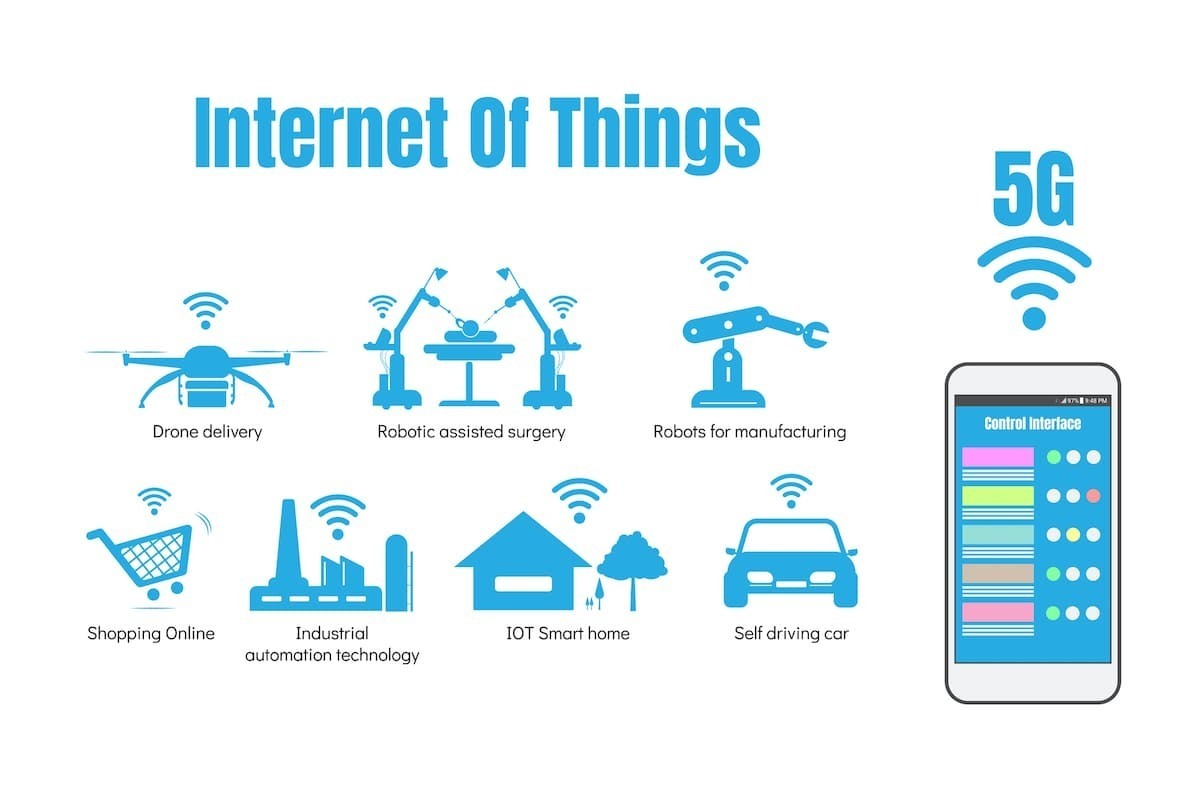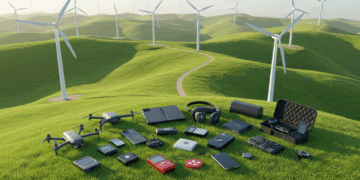Introduction: The Dawn of Hyper-Connected Intelligence
The integration of Fifth-Generation (5G) wireless technology with the burgeoning Internet of Things (IoT) ecosystem represents one of the most significant paradigm shifts in modern history.
This is not simply an evolutionary step from 4G; it is a foundational, revolutionary technology poised to completely restructure global industries, redefine urban infrastructure, and deeply penetrate every aspect of daily life.
While previous generations successfully delivered mobile data and streaming video, 5G introduces a powerful, synchronized triad of capabilities: Enhanced Mobile Broadband (eMBB) for massive speeds, Ultra-Reliable Low-Latency Communications (uRLLC) for near-instantaneous responsiveness, and Massive Machine Type Communications (mMTC) for handling unprecedented device density.
The global count of IoT devices—spanning everything from simple environmental sensors and smart home gadgets to complex industrial robots and sophisticated medical monitoring equipment—is skyrocketing.
However, this growth has been consistently bottlenecked by the inherent limitations of legacy network infrastructures.
Existing cellular and Wi-Fi systems often cannot support the sheer volume of data, the real-time criticality required by advanced applications, or the extended energy efficiency needed for billions of battery-powered sensors.
5G technology is specifically engineered to resolve these bottlenecks. Its deployment marks the critical moment when IoT evolves from a collection of fragmented, specialized systems into a truly cohesive, pervasive, and globally intelligent digital fabric.
This comprehensive article will deeply analyze the profound, multifaceted global impact of 5G on the IoT landscape, exploring its technical enablement, the transformations it drives across critical sectors, the complex challenges it introduces, and the expansive, intelligent future it promises.
I. The Foundational Technology: 5G’s Pillars for IoT Enablement
The transformative power of 5G on IoT is rooted in its three distinct technical capabilities, each essential for unlocking different tiers of smart applications.
A. Enhanced Mobile Broadband (eMBB) – The Speed and Capacity Engine
eMBB is focused on delivering fiber-like speeds wirelessly and dramatically increasing network capacity.
This is achieved through three key innovations: the utilization of higher-frequency millimeter wave (mmWave) spectrum, the deployment of Massive Multiple-Input Multiple-Output (Massive MIMO) antenna arrays, and advanced coding and modulation schemes.
This unprecedented throughput and capacity significantly impact high-data IoT applications:
- A. High-Definition Video Streams
Critical for modern security systems, real-time remote monitoring, and autonomous drone inspection services that require instant transmission of 4K or 8K video feeds for immediate analytical processing. - B. Data-Intensive Diagnostics
Facilitates the rapid transfer of enormous data packets—such as large medical imaging files (MRI, CT scans) or detailed Digital Twin synchronization data—from devices to cloud/edge processing centers. - C. Cloud-Based Processing Efficiency
The massive capacity allows hundreds of thousands of devices in a single localized area to simultaneously upload data without network congestion, enabling efficient cloud-based Artificial Intelligence (AI) and Machine Learning (ML) processing on a vast, planetary scale.
B. Ultra-Reliable Low-Latency Communications (uRLLC) – The Real-Time Command Structure
uRLLC is arguably the most critical component for mission-critical IoT applications. It aims for network delays (latency) as low as 1 millisecond (ms) and network reliability of up to 99.999% (the “five nines”). This shift from “fast” to “instantaneous” is what fundamentally alters control systems.
The applications demanding uRLLC are those where human safety and precise system synchronization are non-negotiable:
- A. Haptic Feedback and Tele-robotics
Essential for remote-controlled surgeries or intricate assembly lines where the lag between operator input and machine response must be imperceptible to maintain control and precision. - B. Autonomous Vehicle Communication
Enables instant decision-making and coordination between vehicles (V2V), traffic lights (V2I), and roadside sensors. A delay of mere milliseconds at high speed could mean the difference between safe navigation and a critical accident. - C. Industrial Control Loops
Allows factories to utilize wireless connections for precision control of robots and machinery, replacing legacy wired protocols with the flexibility of a wireless network without sacrificing the deterministic timing required for synchronized manufacturing processes.
C. Massive Machine Type Communications (mMTC) – The Scaling Enabler
mMTC is designed to handle the sheer volume of devices required for global IoT scale. It provides the ability to support an extraordinary density of up to one million connected devices per square kilometer. More importantly, it is optimized for small data packets and extreme battery life.
This pillar makes widespread, dense IoT deployment economically viable:
- A. Deep Coverage and Penetration
mMTC signals are designed to penetrate deep underground (e.g., smart water meters) and within dense urban environments (e.g., in basements or utility closets), ensuring reliable connectivity where previous generations struggled. - B. Energy Efficiency
It prioritizes power conservation, allowing simple sensors—such as those used for air quality monitoring or logistics tracking—to operate for up to ten years on a single coin-cell battery, drastically reducing maintenance costs. - C. Large-Scale Environmental Monitoring
Facilitates the deployment of billions of low-cost sensors across vast geographical areas for climate tracking, agricultural optimization, and infrastructure health monitoring.
II. Global Sectoral Transformation Driven by 5G-IoT Synergy
The synergistic capabilities of 5G and IoT are not limited to one domain but are fundamentally reshaping the operational blueprints of numerous global industries.
1. Smart Cities and Urban Management
5G provides the necessary backbone to transform static urban infrastructure into dynamic, responsive, and data-driven intelligent systems.
- A. Traffic and Mobility Optimization
Real-time data from 5G-connected cameras, intersection sensors, and vehicles is fed instantly into AI algorithms to dynamically adjust traffic light timings, reroute public transport, and provide predictive alerts, drastically reducing congestion and pollution. - B. Enhanced Citizen Safety
High-resolution, live video streams from networked public cameras, combined with immediate transmission speeds, enable rapid AI analysis for detecting crimes, accidents, or public health incidents, improving emergency response times dramatically. - C. Resource Efficiency
Smart water grids monitor pipeline pressure and flow in real-time to detect leaks instantly, conserving billions of gallons of water annually. Smart waste management systems utilize sensors to optimize collection routes only when bins are full, cutting fuel use and operational costs.
2. Manufacturing, Logistics, and Industry 4.0
The convergence of 5G and Industrial IoT (IIoT) is the engine driving the Fourth Industrial Revolution, centered on hyper-flexibility and automation.
- A. Flexible Factory Layouts
Wireless control enabled by uRLLC allows industrial robots and Automated Guided Vehicles (AGVs) to be instantly reconfigured or moved without the constraints of physical Ethernet cables, enabling mass customization on assembly lines. - B. Advanced Predictive Maintenance (PdM)
IIoT sensors continuously monitor machine health parameters (vibration, acoustics, temperature). The enormous data streams are immediately transmitted via eMBB to AI engines, which can predict equipment failure with high certainty weeks in advance, reducing unplanned downtime by 50% or more. - C. Supply Chain Visibility
mMTC enables low-cost, long-life sensors to be embedded in shipping containers and individual packages, providing continuous, granular tracking of location, temperature, and shock, ensuring the integrity of perishable or high-value goods globally.
3. Healthcare and the Internet of Medical Things (IoMT)
5G is democratizing access to specialized medical care by eliminating the constraints of distance and time.
- A. High-Fidelity Telemedicine
Allows for high-definition, two-way video consultations and the transmission of complex diagnostic data in real-time, enabling specialists in major urban centers to effectively treat patients in rural or remote areas. - B. Remote Patient Monitoring (RPM)
mMTC supports a vast network of wearable and implantable devices (IoMT) that continuously track vital signs (ECG, glucose levels, oxygen saturation). This always-on connectivity allows healthcare providers to monitor chronic conditions and intervene proactively before an emergency occurs. - C. Emergency Response Integration
Paramedics can use 5G to stream patient data, including complex scans and live video of the procedure, directly to the hospital’s trauma team while still in transit. This allows doctors to prepare specialized resources, effectively moving the diagnosis process to the ambulance.
4. Autonomous Vehicles and Transportation
5G is the essential communication layer for achieving Level 4 and Level 5 autonomous driving.
- A. Coordinated Platooning
Low latency allows groups of trucks to travel closely together (“platooning”), minimizing air resistance, saving fuel, and increasing road capacity, all while requiring instantaneous, synchronized braking and acceleration commands. - B. Extended Sensor Range
5G-enabled communication allows vehicles to “see” beyond the line of sight of their on-board sensors, receiving critical data about road hazards, accidents, or icy conditions miles ahead from other connected vehicles and infrastructure. - C. Firmware Updates and Diagnostics
eMBB enables the rapid download of large, complex software and security updates to the vehicles, keeping their operating systems current and secure without requiring a trip to the dealer.
III. Overcoming Challenges in the Global 5G-IoT Transition
The monumental promise of 5G and IoT is tempered by significant global challenges that require coordinated effort from governments, telecom operators, and regulatory bodies.
1. Security, Resilience, and Trust
The massive expansion of the attack surface, with billions of new connected devices, makes security the paramount concern.
- A. Device-Level Vulnerabilities
Many low-cost IoT devices are deployed with weak default security settings and poor patch management, making them easy targets for exploitation and aggregation into powerful botnets for Distributed Denial of Service (DDoS) attacks. - B. Network Slicing Security
5G utilizes Network Slicing to create dedicated virtual networks for different services (e.g., one slice for utilities, another for gaming). Maintaining strict isolation between these slices is crucial; a breach in a non-critical slice must not be allowed to cascade into a mission-critical slice. - C. Privacy Concerns
The pervasive nature of 5G-enabled sensors in smart cities and homes generates an unprecedented volume of behavioral and personal data. Establishing robust, auditable encryption and clear data handling protocols compliant with global mandates (like GDPR or CCPA) is essential to maintain public trust.
2. Infrastructure Deployment and Economic Hurdles
The realization of 5G’s full potential is fundamentally dependent on extensive, complex, and costly infrastructure deployment.
- A. The Challenge of Small Cells
Unlike 4G towers, 5G’s use of high-frequency mmWave spectrum provides massive speed but poor signal propagation. This necessitates the installation of a high density of small cell transceivers on streetlights, buildings, and utility poles—a slow, permitting-intensive, and capital-intensive logistical challenge, particularly in densely populated and historic cities. - B. Fiber Backhaul
Each small cell requires high-capacity fiber-optic cables to connect back to the core network (backhaul). The sheer cost and time required to lay this dense fiber network is often the true bottleneck in 5G deployment. - C. Return on Investment (ROI)
Telecom operators face immense pressure to justify the trillions of dollars invested in 5G infrastructure. Developing clear, profitable, and scalable business models that leverage IoT services (such as charging for guaranteed low-latency slices) is necessary to ensure sustainable deployment.
3. Regulatory, Ethical, and Societal Issues
The advanced capabilities of 5G-IoT raise profound ethical dilemmas and demand new regulatory frameworks.
- A. Liability in Autonomous Systems
In an accident involving a 5G-connected autonomous vehicle or a robotic surgical tool, current laws are often inadequate to determine legal responsibility—does it lie with the device manufacturer, the network operator, the software developer, or the AI algorithm itself? - B. Digital Equity and the Divide
Without targeted investment, 5G-IoT benefits risk being concentrated in wealthy urban and industrialized areas, widening the digital and economic divide between well-connected cities and underserved rural or developing regions. - C. Net Neutrality and QoS (Quality of Service)
5G’s network slicing effectively allows for prioritized traffic (e.g., guaranteeing a low-latency slice for an ambulance). Regulators must establish clear rules to ensure fair access and prevent network slicing from being used in an anti-competitive or discriminatory manner.
IV. The Future Trajectory: Pervasive Intelligence and Beyond
The immediate trajectory of 5G-enabled IoT is towards integrating computing power closer to the end-user, laying the necessary groundwork for future generations.
Edge Computing: Bringing Intelligence to the Source
Mobile Edge Computing (MEC), a core architectural component of 5G, involves distributing computing and storage resources to the edge of the network, closer to the data source.
- A. Ultra-Low Latency Control
Processing data locally at the cell tower or base station dramatically cuts the round-trip delay to the central cloud, meeting the sub-5ms requirement for uRLLC applications like real-time industrial control and traffic management. - B. Bandwidth Optimization
Edge computing allows for filtering, aggregation, and pre-processing of raw sensor data locally. Only critical insights or aggregated data summaries are sent to the core network, significantly reducing the required backhaul bandwidth. - C. Increased Resilience
Edge-based processing allows critical local systems (like a smart grid substation or a factory floor) to maintain operations even if the connection to the central cloud is temporarily lost, improving overall system resilience.
Looking Ahead: The Path to 6G and the Internet of Everything
While 5G is still under global deployment, researchers are already actively defining the capabilities of 6G, anticipated around 2030.
The infrastructure and architectural paradigms established by 5G—massive connectivity, network slicing, and integration with AI/ML—are the essential foundations for the next generation.
6G is projected to introduce features like terahertz frequencies, integrated sensing and communication (where the network is also a sensor), and truly pervasive AI embedded into the network fabric.
The current global impact of 5G on IoT is the crucial first step toward realizing a truly sentient and intelligent global digital ecosystem—the Internet of Everything.
Conclusion
The global impact of 5G on IoT devices transcends a mere technological specification; it is an economic driver and a societal force fundamentally reshaping global infrastructure and human-computer interaction.
By delivering the necessary speeds (eMBB), responsiveness (uRLLC), and scale (mMTC), 5G successfully transforms the long-hypothesized potential of IoT into concrete, real-world solutions.
From performing precise remote surgery and enabling highly efficient, customized industrial production, to orchestrating truly intelligent and sustainable urban environments, the synergy is undeniable.
Though major hurdles remain—particularly in ensuring robust security across a fragmented device landscape, funding pervasive infrastructure deployment, and crafting equitable regulatory frameworks—the irreversible global momentum towards a hyper-connected world is established.
The continued expansion and maturation of the 5G network will not only foster unprecedented innovation and catalyze new multi-trillion-dollar digital economies but will also be the critical infrastructure that defines a more connected, efficient, resilient, and intelligent future for all nations and communities.









